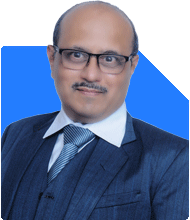What should a 44-year-old IT professional with a growing family do with his finances?
Ramalingam Kalirajan |10870 Answers |Ask -Follow
Mutual Funds, Financial Planning Expert - Answered on Nov 04, 2024
He has an MBA in finance from the University of Madras and is a certified financial planner.
He is the director and chief financial planner at Holistic Investment, a Chennai-based firm that offers financial planning and wealth management advice.... more

I am 44 year old IT professional. I belong to a middle class family. I have 2 daughters. One is in 11th class(16 yrs) and another is in 2nd class(8 yrs). My wife does not work and is housewife. I also have to take care of my parents who has no income source and they don't have medical insurance also. My in hand salary is 1,80,000 Rs(after TDS and EPF). I only have total Rs 10,000 of SIP as of now since 40 months. Mirae Asset Large cap fund - 5k per month Parag Parikh Flexi cap fund - 3k per month SBI Small Cap Fund Growth - 2k per month From this month(Oct 2024) I also started below more SIPs: HDFC Balanced Advantage Fund Direct growth - 5 K Motilal Oswal Midcap Direct Fund - 5k(in wife A/c) Quant Small Cap direct growth - 3k(in wife A/c) TATA Small Cap fund direct growth - 2k(in wife A/c) Also, I increased Parag Parikh Flexi cap SIP to 10,000) So, total 32,000 SIP as of now effective from last month.(me and my wife name). Contribution to EPF is 24K. I am paying rent 22,000 per month. I took a home loan last year for which I am paying EMI of 25k as of now which would be around 35 by next year once I get the flat possession. I also have a small flat of around 45 lakh which is free from Home loan now. It is on rent for 14k per month. Monthly exp : EMI - 22k which will be 35 k soon. Rent - 22k till I get home possession next year. SIP - 32k(me and my wife name) Total around 1 lakh is what my all exp and all investment(mentioned above) cost me as of now. Below are my requirements: Need money for elder daughter for her education soon in 2-4 yrs. Need to create a Corpus for younger daughter in around 10 yrs. Need to have corpus for my retirement. Should I start more SIP. If yes, then how much and which type and ratio. like Large, flexi or small cap fund? Should I sell my old flat to payoff my home loan or should I invest that in SIP all that amount instead? which is better option? How much amount of SIP should I have as of now to achieve my goals.
Current Financial Situation and Analysis
You have a monthly income of Rs. 1,80,000 and SIP contributions of Rs. 32,000 in a mix of equity mutual funds. Additionally, you’re paying rent of Rs. 22,000 and have an EMI of Rs. 25,000, soon to increase to Rs. 35,000 after possession. You also own a small flat valued at Rs. 45 lakh, generating rental income of Rs. 14,000 per month.
Your financial goals are:
Funding your elder daughter’s education within the next 2-4 years
Creating a corpus for your younger daughter’s future in 10 years
Building a retirement fund
Let’s address each goal systematically and suggest ways to enhance your investment strategy.
1. Funding Elder Daughter’s Education in 2-4 Years
Education costs are rising every year, and the time horizon is short, requiring a low-risk approach.
Investment Strategy: For short-term goals, avoid equities as they are volatile. Consider shifting a portion of your SIPs or rental income to safer debt funds, fixed deposits, or recurring deposits. Debt mutual funds like ultra-short-term or low-duration funds are preferable here, as they offer better returns than savings accounts while keeping risks minimal.
Corpus Estimation: Estimate the total funds required based on your daughter’s anticipated course. Since you already have SIPs, you may consider partially redeeming the debt funds at the required time.
Additional Savings: If possible, allocate Rs. 10,000-15,000 from your current income to these safer investments to reach your goal faster.
2. Corpus Creation for Younger Daughter’s Future in 10 Years
This is a mid-term goal, which allows you to benefit from equity market growth, though a balanced approach is advisable.
Suggested Allocation: For this goal, equity mutual funds are suitable due to their growth potential over a 10-year horizon. A diversified portfolio combining large-cap, flexi-cap, and mid-cap funds can balance growth and stability.
Fund Allocation:
Large Cap: 40% of your SIPs in large-cap funds provides stable growth with moderate risk.
Flexi Cap: 30% for flexibility to switch between market capitalisations, potentially capturing higher returns.
Mid Cap: 20% for higher growth potential, though mid-cap funds can be more volatile.
Debt Component: 10% to create a cushion against volatility and ensure liquidity for immediate needs.
SIP Increase: Consider increasing your SIP allocation by Rs. 5,000-10,000 in these funds gradually, if possible, to help accumulate the corpus required over time.
3. Building a Retirement Corpus
Retirement planning is crucial, especially with your responsibilities. With your current age, you have around 16 years to plan.
Target Corpus: Aim for a retirement corpus that can generate monthly income covering your expenses post-retirement. Estimate based on projected monthly expenses and expected returns.
EPF and PPF Contributions: Your EPF contribution of Rs. 24,000 monthly is beneficial. Additionally, investing in PPF can provide tax-free returns and add to your retirement security. Consider increasing PPF contributions if within your budget, as it is safe and offers compounding benefits.
SIP Allocation: Continue SIPs in flexi-cap and large-cap funds for long-term growth. Mid-cap funds can add extra returns but should be balanced with large-cap stability.
Regular Fund Investment via MFD with CFP: Since direct funds do not provide advisory support, investing through an MFD with CFP credentials can help you make strategic adjustments as market conditions change. A Certified Financial Planner’s guidance will keep your retirement goal on track.
Should You Sell the Old Flat?
Selling your old flat has pros and cons. Let’s analyse them to see which option might be better for you.
Option 1: Sell and Invest the Proceeds in SIPs
Selling the flat will release Rs. 45 lakh. If this is invested in SIPs, it could help fund your goals without taking on extra debt.
Advantages:
Higher Growth Potential: If invested in mutual funds, this amount can grow faster than real estate.
Enhanced Liquidity: You have better liquidity, with the option to redeem partial investments when needed.
Disadvantages:
Rental Income Loss: You will lose the Rs. 14,000 per month rental income, which currently adds to your cash flow.
Market Risks: Although SIPs have growth potential, they are subject to market volatility.
Option 2: Retain the Flat and Pay Home Loan EMI
Retaining the flat means you keep the rental income and pay the EMI on your new home loan.
Advantages:
Stable Rental Income: This monthly income supports your expenses or can be saved for future goals.
Equity Growth: You’ll continue to have real estate as a diversified asset in your portfolio.
Disadvantages:
EMI Burden: The increased EMI (Rs. 35,000) can strain your cash flow.
Limited Liquidity: Real estate is an illiquid asset, making it harder to access funds for immediate needs.
Recommendation: If your retirement and children’s corpus goals require more funding, selling the flat could be a practical choice. The proceeds can be invested to grow faster. However, if you value the rental income, consider retaining it and adjusting your SIPs and other investments accordingly.
Optimal SIP Strategy for Goal Achievement
Given your goals, here is a potential SIP structure for better returns and risk balance:
Large-Cap Funds: 40% of your SIPs for steady growth and reduced volatility.
Flexi-Cap Funds: 30% allocation, allowing fund managers to shift between small, mid, and large caps.
Mid-Cap Funds: 20% allocation for high growth with moderate risk.
Debt Mutual Funds: 10% in debt mutual funds for safety and liquidity, especially for the education goal.
Consider maintaining this allocation with regular monitoring by an MFD with CFP credentials. Actively managed funds can offer a better edge than index funds, with fund managers striving for optimal returns over time.
Additional Recommendations for Long-Term Stability
Health Insurance for Parents: Since your parents do not have any income or medical insurance, consider purchasing a family floater or senior citizen health insurance plan. This will prevent high medical costs from affecting your finances.
Emergency Fund: Ensure an emergency fund of at least six months' expenses in a high-interest savings account or liquid fund. This keeps funds accessible for unforeseen needs.
Regular Review: Financial markets change, and it’s essential to periodically review your SIPs and asset allocations. Adjustments based on your goals and risk tolerance will keep your financial plan effective.
Finally
You’re on the right track, having taken proactive steps in SIPs and real estate. With a focused approach to SIP allocation, goal-based planning, and periodic reviews, you can meet your family’s needs comfortably. Ensure a consistent increase in your SIPs, protect your family with insurance, and aim for long-term wealth growth.
Best Regards,
K. Ramalingam, MBA, CFP,
Chief Financial Planner
www.holisticinvestment.in
https://www.youtube.com/@HolisticInvestment
You may like to see similar questions and answers below
Ramalingam Kalirajan |10870 Answers |Ask -Follow
Mutual Funds, Financial Planning Expert - Answered on Oct 01, 2024
Ramalingam Kalirajan |10870 Answers |Ask -Follow
Mutual Funds, Financial Planning Expert - Answered on Oct 03, 2024
Nitin Narkhede | Answer |Ask -Follow
MF, PF Expert - Answered on Jul 02, 2025
Ramalingam Kalirajan |10870 Answers |Ask -Follow
Mutual Funds, Financial Planning Expert - Answered on Dec 02, 2025
Dr Shyam Jamalabad |107 Answers |Ask -Follow
Dentist - Answered on Dec 05, 2025
Dr Shyam Jamalabad |107 Answers |Ask -Follow
Dentist - Answered on Dec 05, 2025
Dr Dipankar Dutta |1836 Answers |Ask -Follow
Tech Careers and Skill Development Expert - Answered on Dec 05, 2025
Ulhas Joshi |280 Answers |Ask -Follow
Mutual Fund Expert - Answered on Dec 05, 2025
Dr Dipankar Dutta |1836 Answers |Ask -Follow
Tech Careers and Skill Development Expert - Answered on Dec 04, 2025
Ravi Mittal |676 Answers |Ask -Follow
Dating, Relationships Expert - Answered on Dec 04, 2025
Anu Krishna |1745 Answers |Ask -Follow
Relationships Expert, Mind Coach - Answered on Dec 04, 2025
Anu Krishna |1745 Answers |Ask -Follow
Relationships Expert, Mind Coach - Answered on Dec 04, 2025
Mayank Chandel |2562 Answers |Ask -Follow
IIT-JEE, NEET-UG, SAT, CLAT, CA, CS Exam Expert - Answered on Dec 04, 2025
Mayank Chandel |2562 Answers |Ask -Follow
IIT-JEE, NEET-UG, SAT, CLAT, CA, CS Exam Expert - Answered on Dec 04, 2025




























